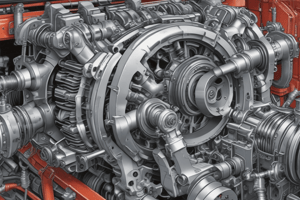Podcast
Questions and Answers
What is the main function of the crankshaft in a reciprocating engine?
What is the main function of the crankshaft in a reciprocating engine?
- Absorbing excess heat from the engine
- Regulating the air-fuel mixture ratio
- Converting reciprocating motion into rotational motion (correct)
- Controlling the fuel injection process
Which materials are commonly used to manufacture crankshafts?
Which materials are commonly used to manufacture crankshafts?
- Plastic, rubber, and glass fiber
- Stainless steel, copper, and zinc
- Titanium, tungsten, and lead
- Cast iron, forged steel, and aluminum alloys (correct)
Why is cast iron a popular choice for crankshaft material?
Why is cast iron a popular choice for crankshaft material?
- For its exceptional resistance to corrosion
- Because it is the lightest material available
- Due to its low cost and easy availability
- Due to its strength and ability to dissipate heat (correct)
What is the typical cross-section of a crankshaft?
What is the typical cross-section of a crankshaft?
What is the main function of the crankshaft in an engine?
What is the main function of the crankshaft in an engine?
Which manufacturing method involves pouring molten metal into a mold to create the basic shape of the crankshaft?
Which manufacturing method involves pouring molten metal into a mold to create the basic shape of the crankshaft?
What is a key consideration for the crankshaft's bearing surfaces?
What is a key consideration for the crankshaft's bearing surfaces?
How does the weight of the crankshaft vary?
How does the weight of the crankshaft vary?
What influences the performance of a crankshaft?
What influences the performance of a crankshaft?
Why is a well-designed and well-manufactured crankshaft important for an engine's performance?
Why is a well-designed and well-manufactured crankshaft important for an engine's performance?
Flashcards are hidden until you start studying
Study Notes
Crankshaft: Design, Materials, Function, Manufacturing, Performance, and Specs
The crankshaft is a crucial component in reciprocating engines, such as the piston engine. It is responsible for converting reciprocating motion into rotational motion and is a central component within the engine's cylinders. In this article, we will explore the design, materials, function, manufacturing, performance, and specifications of the crankshaft.
Design
A typical crankshaft is a cylindrical shaft with an asymmetrical cross-section, consisting of a series of connecting rods and pistons. It is designed to be stiff and to resist torsional stresses, while also being able to accommodate varying stresses from the engine's pistons. The crankshaft is usually made of cast iron or steel.
Materials
The materials used for crankshafts include cast iron, forged steel, and various types of aluminum alloys. These materials are chosen for their strength, durability, and ability to withstand the high stresses and temperatures encountered in the engine. Cast iron is a popular choice due to its strength and ability to dissipate heat. Forged steel is also used for high-performance applications, as it can be made thinner and lighter than cast iron. Aluminum alloys are used in smaller engines due to their light weight and ease of machining.
Function
The crankshaft plays a crucial role in the operation of a reciprocating engine. It converts the reciprocating motion of the pistons into rotational motion, which is then transmitted to the engine's output shaft. The crankshaft is connected to the pistons through connecting rods, and it rotates at a much slower speed than the pistons.
Manufacturing
Crankshafts can be manufactured using various methods, including casting, forging, and machining. Casting involves pouring molten metal into a mold, which is then allowed to cool and harden. This process is used to create the basic shape of the crankshaft, which is then machined to precise dimensions. Forging involves heating the metal to a high temperature and shaping it using a hammer or press. This process is used to create a more uniform and stronger crankshaft. Machining is used to finish the crankshaft and bring it to its final dimensions.
Performance
The performance of a crankshaft is influenced by its design, materials, and manufacturing process. A well-designed and well-manufactured crankshaft can provide excellent performance, with high levels of strength and durability. The crankshaft's ability to withstand the high stresses of the engine is crucial for the overall performance of the engine.
Specs
Crankshaft specifications vary depending on the engine and its intended use. Key specifications to consider include:
- Length: The length of the crankshaft is determined by the engine's stroke and the number of cylinders.
- Weight: The weight of the crankshaft is influenced by the materials used and the engine's power output.
- Bearing Surfaces: The crankshaft's bearing surfaces must be machined to very precise specifications to ensure smooth operation and longevity.
In conclusion, the crankshaft is a vital component in reciprocating engines, responsible for converting reciprocating motion into rotational motion. Its design, materials, manufacturing process, and performance specifications all play a role in determining its overall performance and durability.
Studying That Suits You
Use AI to generate personalized quizzes and flashcards to suit your learning preferences.




